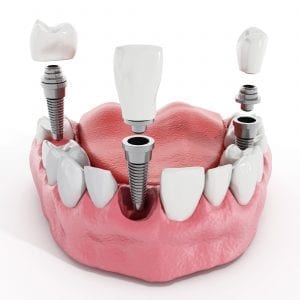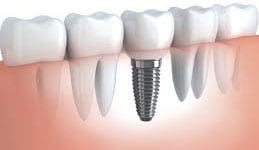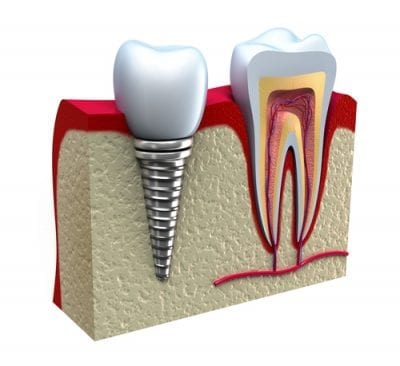All-on-4, all-on-6, and all-on-8 implant procedures are dental procedures involving dental implantation (endodontic) therapy that involve strategically placing 4 to 6 implants into your mouth in order to make it easier to place a set of dentures or crowns in the area. The all on 4 implants are typically done on people with large gaps of teeth missing. It’s a one-day procedure that permanently replaces teeth and restores your bite in one fell swoop.
This is a branded procedure that utilizes titanium metal posts as anchors to dentures for the lower and upper jaw on those who’ve lost most or all of their teeth. Instead of putting one crown at a time on one dental implant, a whole section or set of teeth is placed instead, allowing four to eight sections of a whole row of dentures to get fitted into a given mouth. This gives the prosthetic teeth a strong foundation of sorts.
Why Only 4 or 6 Implants?

You only need 4 to 6 (or even 8) implants to anchor teeth on the upper or lower jaw. The pair of implants acts like posts on a dental bridge where you’re supposed to place porcelain crowns or dentures. That’s why the implant procedure only requires 4 or 6 implants. This way, you get a strong foundation for your prosthetic or false teeth, which are then placed on every titanium post afterwards to complete what’s supposed to be a permanent procedure.
It’s all thanks to implant technology advances that four implants are all it takes at the bottom or the top jaw to get your new teeth fitted. This is especially advantageous in light of the following facts:
- It takes fewer implants to get the job done (to be more specific, just all on 8, all on 4, or all on 6 implants). You don’t need to insert 16 or more implants.
- The results are more permanent than simply doing multiple bridges on existing teeth.
- It’s best used on people who’ve lost most or all of their teeth.
- You don’t need to subject your mouth to the trauma of having multiple implant surgeries.
- The dental implant procedure is a one-visit operation since the planning stage includes manufacturing of the false teeth and taking a scan or cast of the mouth for a perfect fit.
- An elderly person can handle a one-operation implant dentistry fitting compared to multiple operations that span across months or even years.
- It’s a lot more affordable since you only have to avail of one package (including bulk discounts) rather than getting individual expensive implants.
Why Should You Avail of These Implants?
Among adults, tooth loss is quite common, especially among older folk. Most people don’t talk about it, but you can’t change human nature. 35 million adult Americans have missing lower or upper teeth, usually the molars since those are the easiest to hide when you smile. Others have imperfect or missing front teeth because they can’t afford buying false teeth, veneers, crowns, or a full-blown dental implant procedure to cover them up.
Only a handful of individuals follow dental advice when it comes to avoiding sweets or taking care of their teeth, resulting in:
- Missing teeth
- Broken teeth
- Dead and crumbling teeth
- Inflamed tooth roots
- Loose teeth
- Gingivitis
- Periodontitis
- Other conditions that necessitate tooth extraction
You can save their teeth through prophylaxis, deep cleaning, and other preventive measures, but what if you’ve already lost the teeth itself? That’s where restorative and cosmetic dentistry comes in, usually in the form of an implant procedure and the like. Indeed, in such cases the best way to avoid gummy smiles and lack of teeth is either dentures that you have to put away in a glass of water or applying for all on 4 implants or all on 6 implants.
Implant Affordability According to Economic Status

People would rather save their money and pay for 4 implants, 6 implants, or 8 implants than dealing with dentures if they can afford it. To wit:
- The Poor: Most poor people don’t bother with dentures at all, resulting in their infamously less-than-perfect homeless person or ghetto smiles full of missing or discolored teeth. They can’t afford it so they just shrug and accept their toothlessness as unavoidable.
- The Middle Class: Most blue-collar workers with no dental insurance plans with their companies try to make do with dentures, but feel ashamed of them since those false teeth are mostly associated with the elderly in old folks’ homes. In other words, getting false teeth is the dental equivalent of getting a toupee or wig.
- The Rich: The humiliation of having a gummy smile pushes most of the middle-class to save up for what’s usually readily available to the rich white-collar managers and bosses, which are all-on-four (or more) dental implants. Rich people tend to have good dental services, so it’s actually rare for them to need all-on-four implantation if they can help it.
Understanding Dental Implantation
In order to have a better appreciation of this unique method of teeth replacement, you should know what a dental implant entails first. Dental implantation or an endodontic therapy involves using a small titanium screw (it’s titanium so that it can last you a lifetime) that fits within your jawbone. It’s crewed to the bone the same way your natural permanent teeth are lodged into the tooth socket It replaces the root part of the tooth you lost, essentially.
However, you can’t just screw the titanium screw into your gum (much less have an all on 4 implants to all on 6 implants) without properly removing the gum then stitching it back together. It makes about as much sense as stabbing yourself with a screw and saying that’s your new implant. It’s painful, it can lead to infection, and it won’t heal right if you go about it that way. After the implant procedure is done, that’s when the functional prosthetic tooth or crown that’s realistic looking will be placed on the anchored titanium post.
In the case of more teeth missing, you could attach multiple false teeth in a row instead of just one tooth. This thus returns your bite and gives you an aesthetically great looking smile. Many celebrities opt for this operation in case they’re missing multiple teeth or wish to correct their bite. Some are even willing to pull out all their teeth in favor of putting in a new set of chompers, but only because they can afford such a major operation.
Step-by-Step Description of the 4-on-All and Above Procedure
Most people don’t know what to expect when undergoing the all-on-four, all-on-six, and even all-on-eight dental implant procedure. They’re curious in regards to what the steps are and what happens as you receive your new set of teeth. As such, here’s a step-by-step description of the procedure for your perusal. This should assist you in knowing what to expect from the initial consultation to the final product, which is your new permanent smile.
Initial Screening Consultation: You need to first visit the highly specialized team tasked to do your procedure. This typically involves a 3D CT scan of your mouth for the sake of oral evaluation. You will then discuss with the doctor the viability of going the all-on-four route or whether or not more affordable potential treatments should be considered. It’s through this appointment or series of meetings that a clinical examination of the mouth will be done, including the scan.
The 3D Cone Beam CT Scan should reveal how healthy and thick your upper/lower jawbone is. You should have enough room on your jawbone to screw the dental implant there, or else implant dentistry isn’t the best course of action for you. Otherwise, you’ll need to pay extra for bone grafting so that you’d have enough bone in your upper or lower jaw for the implant to anchor itself with.
Preparation: This is the step to be taken after careful planning on how your set of teeth will look on your jaw has already been outlined. On the day of the treatment itself, you’ll be prepped up by doing the following. You will first be escorted to a private room where you’ll settle in while your loved ones can accompany you up to the lobby for moral support. You will then be given pre-op advice and instructions
You’ll also be given medications to prep you up. If you feel nervous or have any questions to the dentist, you can ask them then and there too, since it’s the priority of the doctor to keep you comfortable. You’ll then be transferred to the surgical suite where you’ll get your sedatives or anesthesia. This will relax and ease you while keeping you from feeling pain as the dental implant surgeon works on your mouth.
The Procedure Itself: The procedure itself involves preparing your mouth for dental implant reception, which entails cleaning out chronically infected or diseased tissue in your gums and jaw through deep cleaning. From there, two dental implants are screwed on the front of your jaw. This involves making a gun on the gums, screwing the implants to the part of the jaw bone that’s resistant to atrophy, and sewing the gum back in place around the implants.
Then, on a 45° angle closer to the back of the jaw, another pair of implants is placed. This angle allows the all on 4 implants or all on 6 implants to reap great structural stability for what’s essentially a dental bridge that involves the implants and their abutment as a bridge support instead of shaved existing teeth. From there, all the dentist needs to do is clean the surgical sites and suture up the incisions. You’ll then be wheeled to your recovery room where you’ll be given time to relax and wake up from being sedated.
The Prosthetic Phase: This is the phase of the implant procedure where you’ll be fitted with your permanent dentures or set of false teeth (essentially dental bridges) that fit right unto the dental implant support posts. It’s the prosthodontist who does the final touches in manufacturing your temporary prosthetic dental bridge as you rest up from undergoing this surgery. You’ll have your new set of teeth fitted into your mouth for a practice run.
Afterwards, you’ll be fitted with a more permanent prosthetic dental bridge made of porcelain crowns that takes a few weeks or months to synthesize properly. The temporary set of teeth can be adjusted to be better fitting, more comfortable, and easier to bite food with. Your more permanent bridge dentures will be based on the setting and customization you prefer your temporary chompers to be in. For now, the temp bridge will give you an instant smile worthy of a celeb.
Post-Operative Care

After everything is said and done in regards to the actual dental implant procedure itself, including the prosthetic phase, you’ll then undergo prosthetic care. This involves checkups and detailed instructions on how to take care of your new set of teeth from the temporary crowns to the more permanent ones made of long-lasting material. You will be taught by staff how to take care of your teeth in the following days and weeks. You will be specifically taught the following:
- Follow an oral hygiene routine
- Eat a soft-food diet or even liquid diet
- Know what habits you should avoid:
- Contact sports
- Heavy exercise
- Excessive drinking
- Smoking
- Allow your implants to heal
As long as you can avoid these things that could heavily compromise your implant’s ability to permanently bond with your jaw’s bone, then you’re good to go with the implant procedure. As an additional precaution, you’ll also have to take anti-inflammatory, antibiotics, and pain medication in order to better deal with the healing stage of your all on 4 implants to all on 6 implants procedure.
To be more specific, there are so many ways to address potential complications, infections, and discomfort from this all-in-one implant package that these issues are usually the least common ones for you to worry about when push comes to shove. It’s literally the furthest thing from your mind in regards to this dental implant procedure, and when all is said and done, you should end up with pearly whites worthy of top Hollywood celebrity.
Thantakit International Dental Center is Thailand’s longest established dental center. Situated in Bangkok, our clinic is renowned across the world as a destination for world-class dentistry, with most of our patients flying to us from Australia.
Contact us today to get FREE dental consultation.












